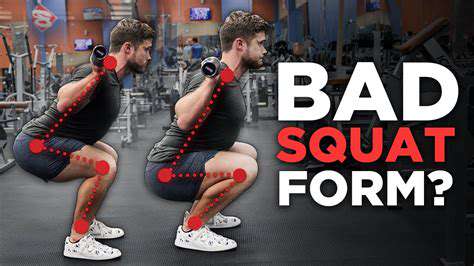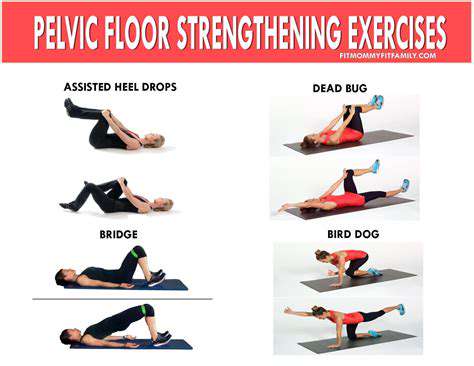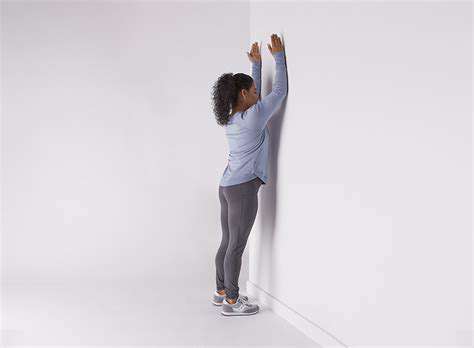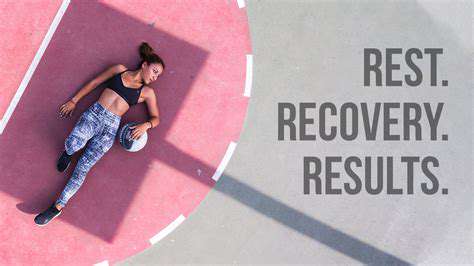How to Perfect Your Squat Form for Maximum Results

Improving Posture and Movement
Good posture isn't just about appearances—it's the backbone of physical health. When your body aligns properly, every movement becomes more efficient and less taxing. Slouching or hunching creates unnecessary strain, leading to aches that can persist for years. The simple act of standing tall with shoulders relaxed and core engaged can prevent countless musculoskeletal issues down the road. Imagine your spine as a stack of blocks—when they're perfectly aligned, the structure stands strong with minimal effort.
Movement efficiency transforms daily activities into opportunities for strength building. Whether lifting groceries or playing tennis, coordinated motion conserves energy while maximizing results. Thoughtful movement patterns create a protective buffer against injuries, particularly during high-impact activities. It's not about moving faster, but smarter—each motion should flow from one to the next with purpose and control.
The Role of Muscles and Joints
Your musculoskeletal system functions like a sophisticated pulley system. Muscles contract and relax in precise sequences, while joints provide the pivot points for motion. This intricate dance allows everything from delicate finger movements to powerful leaps. When one element falters—whether tight muscles or stiff joints—the entire system compensates, often leading to discomfort or injury.
Joint health deserves particular attention as we age. Synovial fluid—nature's lubricant—keeps joints moving smoothly, but only if we maintain regular movement. A balanced approach combining strength training with mobility exercises creates resilient joints capable of handling life's demands. Healthy joints are the unsung heroes behind every pain-free movement, from tying shoelaces to climbing stairs.
Muscle balance proves equally crucial. Overdeveloped chest muscles paired with weak upper back muscles, for instance, create the hunched posture so common today. Targeted strength training combined with stretching creates symmetry, allowing the body to function as nature intended. This balanced approach transforms exercise from a chore into preventive medicine for your musculoskeletal system.

Descending Deeply: Maintaining Control and Preventing Injury
Understanding the Mechanics of Descent
The art of squatting begins with mastering the descent. Picture lowering yourself into a chair with perfect control—hips moving back as knees track over toes, spine maintaining its natural curves. This controlled motion protects vulnerable knee ligaments while building strength through the full range of motion. The descent isn't merely preparation for the ascent; it's where proper form prevents most squat-related injuries.
Knee alignment makes or breaks squat technique. When knees collapse inward (valgus collapse), they bear unnatural forces that can lead to chronic pain. Conversely, knees pushed too far outward strain different structures. The sweet spot lies in tracking knees directly over toes throughout the movement—a simple concept requiring constant mindfulness until it becomes second nature.
Preventing Injury During the Descent
Weight distribution forms the foundation of safe squatting. Imagine your foot as a tripod—weight evenly distributed between heel, big toe mound, and little toe mound. This stable base allows proper force transfer up the kinetic chain. When weight shifts too far forward or back, joints compensate, increasing injury risk.
Spinal alignment deserves equal attention. The spine's natural curves—slight inward curve in the neck and lower back, outward curve in the upper back—must remain intact during squats. Maintaining this neutral spine position protects intervertebral discs from excessive compression while allowing optimal force transfer. Core bracing—activating abdominal and back muscles—creates the necessary support system for this alignment.
Preparation and recovery complete the injury prevention picture. Dynamic warm-ups prepare tissues for loading, while post-workout mobility work prevents stiffness. These bookends to your workout session are as crucial as the exercises themselves for long-term joint health.
The Ascent: Power and Precision
Understanding the Fundamentals
Squat mastery begins with respect for the basics. Like building a house on solid foundations, perfecting body alignment pays dividends in strength gains and injury prevention. Beginners often focus on depth or weight before establishing proper mechanics—a recipe for frustration and potential injury. The journey to squat proficiency starts with bodyweight mastery before adding external load.
Tempo control separates effective squats from risky ones. A deliberate, controlled pace allows continuous muscle engagement throughout the movement. Rushing sacrifices form and reduces muscle activation—two factors critical for progress. Patience in the learning phase creates the neuromuscular patterns needed for advanced variations later.
Maintaining a Neutral Spine
The spine's neutral position acts as the body's natural shock absorber during squats. Visualize your spine as a flexible rod—it can bend but maintains structural integrity under load. Excessive rounding (flexion) or arching (extension) compromises this integrity, potentially leading to herniated discs or muscle strains.
Core engagement provides the muscular corset supporting spinal alignment. Proper bracing—inhaling into the abdomen and contracting all surrounding muscles—creates intra-abdominal pressure that stabilizes the entire torso. This technique distributes forces evenly across the core rather than concentrating them in the lower back.
Foot Placement and Stability
Foot position dictates squat mechanics more than most realize. While shoulder-width apart serves as a general guideline, individual anatomy requires adjustments. Those with longer femurs often benefit from wider stances, while others may prefer narrower placements. The key lies in finding a position allowing full depth without compromising form.
The foot's contact with the ground tells its own story. Maintaining all three contact points (heel, big toe, little toe) ensures proper force distribution through the kinetic chain. This tripod foot concept prevents excessive stress on any single joint while maximizing power output.
Controlling the Movement and Breathing
Breath control transforms squats from mere exercises to full-body tension management systems. The Valsalva maneuver—inhaling before descent and exhaling upon ascent—creates crucial intra-abdominal pressure. This pressurized system stabilizes the spine much like air stabilizes a bicycle tire.
Rhythmic breathing synchronizes with movement for optimal performance. Inhaling during the eccentric (lowering) phase and exhaling during the concentric (rising) phase matches breath to effort. This synchronization maintains oxygen flow while providing spinal support when most needed.
Progression and Customization: Tailoring the Squat to Your Needs
Understanding Your Baseline
Effective squat programming begins with honest self-assessment. Mobility screenings reveal limitations in ankles, hips, or thoracic spine that might affect squat depth or form. Strength imbalances between quadriceps and hamstrings or between left and right sides highlight areas needing attention before progressing.
Past injuries create unique considerations. Knee surgery survivors might prioritize box squats initially, while those with back issues may focus on goblet variations. Respecting these individual differences prevents setbacks and ensures sustainable progress. Professional guidance proves invaluable for navigating these nuances safely.
Progressive Overload: Gradual Improvement
The principle of progressive overload applies to squats as to all strength training. However, progression manifests in multiple dimensions beyond simply adding weight. Increasing range of motion, improving control at the sticking point, or adding tempo variations all constitute legitimate progression paths.
Small, consistent improvements—whether an extra rep, deeper range, or better control—compound into remarkable transformations over time. This patient approach builds durable strength while minimizing injury risk from overly aggressive loading.
Adapting for Different Goals
Squat variations serve different athletic purposes. Powerlifters prioritize maximal strength through low-rep, high-load back squats. Sprinters benefit from explosive jump squats developing fast-twitch fibers. Bodybuilders might emphasize hypertrophy through moderate-weight, high-rep front squats.
Even within sports, position-specific needs vary. A basketball center requires different squat attributes than a point guard—demonstrating the importance of goal-oriented programming. Understanding these distinctions ensures training aligns with desired outcomes.
Customization and Modifications
Individual anatomy dictates ideal squat mechanics. Those with long femurs relative to torso length often adopt wider stances for balance. Ankle mobility limitations may necessitate heel elevation. These aren't compromises but intelligent adaptations.
Assistance tools expand possibilities. Resistance bands help groove proper movement patterns for beginners. Safety bars catch weights if form breaks down. Smart modifications don't dilute effectiveness—they enable continued progress within individual constraints.
Read more about How to Perfect Your Squat Form for Maximum Results
Hot Recommendations
-
*Guide to Managing Gout Through Diet
-
*Best Habits for Financial Well being
-
*How to Build a Routine for Better Mental Health
-
*How to Eat Healthy on a Budget [Tips & Meal Ideas]
-
*Guide to Practicing Self Acceptance
-
*How to Incorporate More Movement Into Your Day
-
*Guide to Managing Chronic Pain Naturally
-
*Guide to Building a Reading Habit for Well being
-
*Top 5 Weight Loss Supplements That Actually Work
-
*Best Exercises for Postpartum Recovery [Beyond Abdominal Work]

![Best Books on Mental Health and Well being [Recommended Reads]](/static/images/26/2025-05/CultivatingSelf-CompassionandPositiveSelf-Talk.jpg)




![Best Snacks for Diabetics [Approved List]](/static/images/26/2025-05/HealthyFatsandComplexCarbohydrates.jpg)
![How to Choose Sustainable Seafood [A Guide]](/static/images/26/2025-05/ExploringSeafoodChoices3ASpeciesandRegionalConsiderations.jpg)



